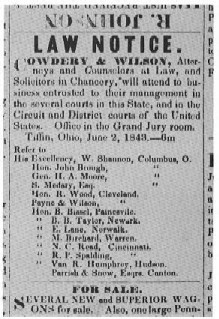
FAIR is a non-profit organization dedicated to providing well-documented answers to criticisms of the doctrine, practice, and history of The Church of Jesus Christ of Latter-day Saints.
Several families, numbering about fifty souls, took up their line of march from this town last week for the “promised land,” among whom was Martin Harris, one of the original believers in the “Book of Mormon.” Mr. Harris was among the early settlers of this town, and has ever borne the character of an honorable and upright man, and an obliging and benevolent neighbor. He had secured to himself by honest industry a respectable fortune—and he has left a large circle of acquaintances and friends to pity his delusion.
—“Several families . . .,” Wayne Sentinel (Palmyra, New York) (27 May 1831). off-site
Mr. Cowdery was an able lawyer and a great advocate. His manners were easy and gentlemanly; he was polite, dignified, yet courteous...With all his kind and friendly disposition, there was a certain degree of sadness that seemed to pervade his whole being. His association with others was marked by the great amount of information his conversation conveyed and the beauty of his musical voice. His addresses to the court and jury were characterized by a high order of oratory, with brilliant and forensic force. He was modest and reserved, never spoke ill of any one, never complained.
—William Lang, History of Seneca County (Springfield, Ohio, 1880), 365.
It is claimed that the witnesses cannot be trusted, or are unreliable, because they were unstable personalities, prone to enthusiasm and exaggeration.
The witnesses were men considered honest, responsible, and intelligent. Their contemporaries did not know quite what to make of three such men who testified of angels and gold plates, but they did not impugn the character or reliability of the men who bore that testimony.

William Lang, who apprenticed in Cowdery's law office, knew him for many years. Lang was a member of the Ohio bar, and served as "prosecuting attorney, probate judge, mayor of Tiffin, county treasurer, and two terms in the Ohio senate. He was nominated by his party for major state offices twice." [1]
Lang wrote of Cowdery:
Harvey Gibson, a political opponent of Oliver's, and another lawyer (whose statue now stands in front of the Seneca County courthouse) wrote:
Even early anti-Mormons who knew Harris, or knew those acquainted with Harris, believed that he was “honest,” and “industrious,” “benevolent,” and a “worthy citizen.” [4] Wrote the local paper on Harris' departure with the Saints:
Pomeroy Tucker, who knew Harris but didn’t believe in the Book of Mormon, once noted:
Some have argued that Harris' tendency to associate with a number of LDS "splinter groups" indicates that he was "unstable and easily influenced by charismatic leaders." [7]
This claim fundamentally distorts Harris' activities during this period. [8] Wrote Matthew Roper:
Throughout Richmond, Missouri, the non-Mormons knew David Whitmer as an honest and trustworthy citizen. When one anti-Mormon lectured in David’s hometown, branding David as disreputable, the local (non-Mormon) paper responded with “a spirited front-page editorial unsympathetic with Mormonism but insistent on ‘the forty six years of private citizenship on the part of David Whitmer, in Richmond, without stain or blemish.’” [10]
This is the critical issue of the life of David Whitmer. During fifty years in non-Mormon society, he insisted with the fervor of his youth that he knew that the Book of Mormon was divinely revealed. Relatively few people in Richmond could wholly accept such testimony, but none doubted his intelligence or complete honesty. [11]
This is what is known as a "ad hominem" attack on the witnesses' character. The term "ad hominem" is defined, according to Merriam-Webster, as:
The accusation that the witnesses are unreliable applies both of these definitions:
However, one must consider this: The Three Witnesses all left the Church after serious disagreements with Joseph Smith, and yet never denied that they had seen the plates and the angel, even near the end of their lives.
The fact that three different men allowed their name to be printed below a statement saying that they saw an angel, and then continued to affirm that they had seen the angel in public statements (some of them even published in newspapers) until the end of their lives, tends to tip the scale more toward "it really happened" than "it didn't happen."
That's the point of a signed statement after all.

FAIR is a non-profit organization dedicated to providing well-documented answers to criticisms of the doctrine, practice, and history of The Church of Jesus Christ of Latter-day Saints.
We are a volunteer organization. We invite you to give back.
Donate Now